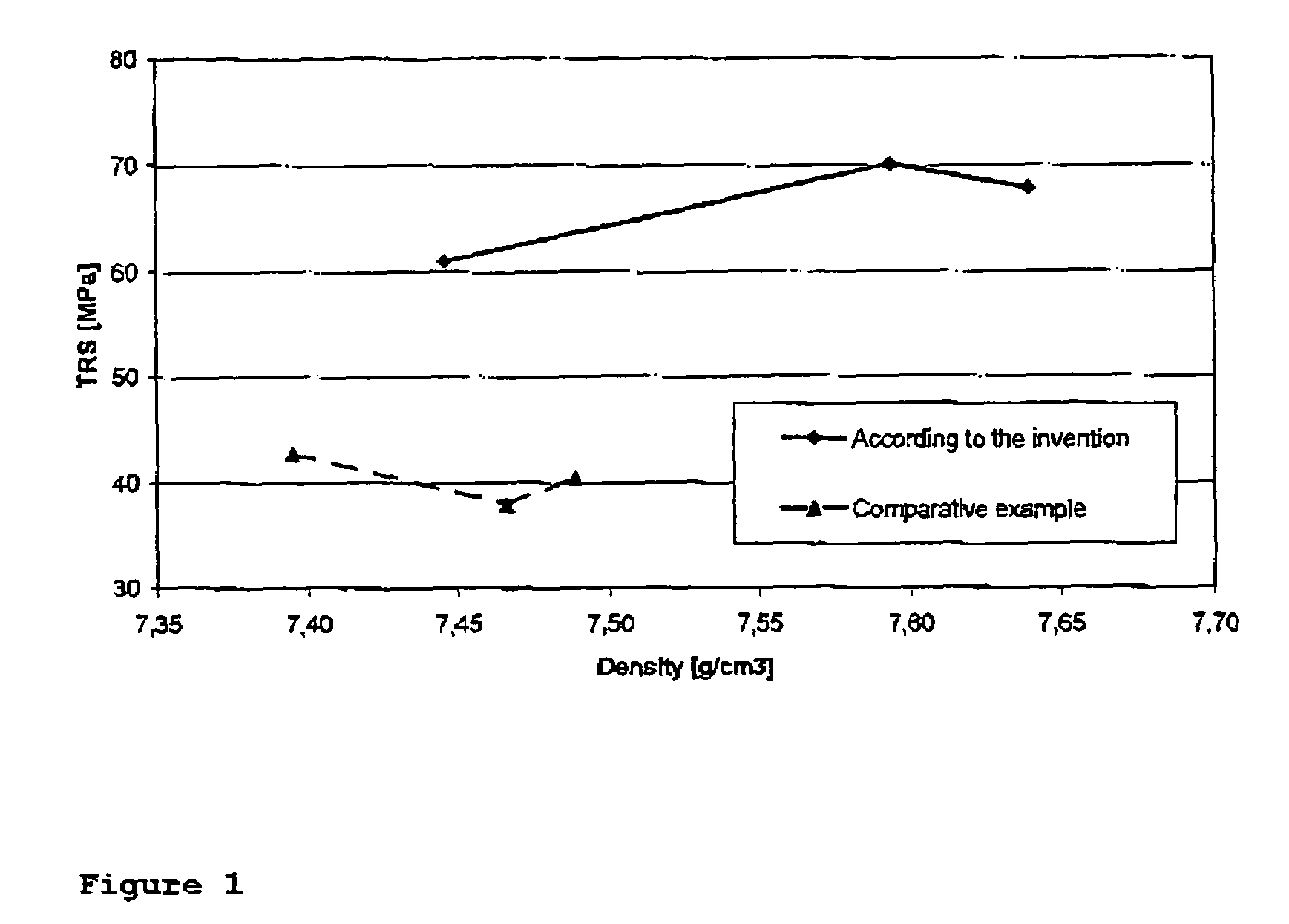Iron-based powder
a technology of iron-based powder and iron-based powder, which is applied in the direction of cellulosic plastic layered products, natural mineral layered products, transportation and packaging, etc., can solve the problems of energy loss and hysteresis loss
- Summary
- Abstract
- Description
- Claims
- Application Information
AI Technical Summary
Benefits of technology
Problems solved by technology
Method used
Image
Examples
example 1
[0026]An iron-based water atomised powder (Somaloy 550™, available from Höganäs AB, Sweden) was used as starting material. This powder has an average particle size between 212 and 425 μm and less than 5% of the particles have a particle size below 45 μm. This powder, which is a pure iron powder, the particles of which are electrically insulated by a thin phosphorus containing barrier, was treated with 0.2% by weight of a hexadecyl-trimethoxy silane as a lubricating agent. The addition of the lubricating agent was performed as follows: hexadecyl-trimethoxy silane was diluted in ethanol to a 20% solution by weight and the solution was stirred during 60 minutes. An amount of this solution corresponding to 0.2% by weight was added during mixing to the iron powder, which had previously been heated to 75° C. in the mixer. An intensive mixing was carried out in the same mixer during 3 minutes followed by mixing at a lower speed during 30 minutes and during vacuum in order to evaporate the ...
example 2
[0034]A very high purity water atomised iron-based powder, the particles of which were provided with a thin insulating coating and which had a mean particle size above 212 μm was treated with 0.1% and 0.2% of hexadecyl-trimethoxysilane, respectively, according to the procedure in Example 1. The same iron-based powder without any lubricating agent was used as a reference.
[0035]Cylindrical samples with a diameter of 25 mm and a height of 4 mm were compacted in an uniaxially press movement at a compaction pressure of 1000 MPa.
[0036]Table 2 shows the ejection energy needed for ejecting the components and the green density obtained. The ejection energy is expressed as percentage of the ejection energy for the sample without lubricating agent.
[0037]
TABLE 2GreenRelativeAmount ofdensityEjectionsilane(g / cm3)Energy %Surface finish 0%7.66100Seizure0.1%7.6758Good0.2%7.6648Good
[0038]From table 2 it can be seen that the energy needed for ejection is considerably reduced and the surface finish is...
example 3
[0039]This example demonstrates the effect of the chain length of the unhydrolysed group or groups (R2) of the organo-metallic compound on the lubricating properties at ejection-after compaction with high pressures. In this example various types and amounts of alkyl-alkoxy silanes (central atom Si) are used as lubricating agent. Two kinds of high purity water atomised iron-based powder provided with a thin insulating coating with two different particle size distributions were used to show the influence of the particle size. The S-powder has about 14% of the particles less than 45 μm and a weight average particle size of about 100 μm. The C-powder has a significantly coarser particle size distribution with a weight average size of about 250 μm and less than 3% below 106 μm.
[0040]Five different kinds of organo-silanes were used (A–E):[0041]A Methyl-trimethoxy silane[0042]B Propyl-trimethoxy silane[0043]C Octyl-trimethoxy silane[0044]D Hexadecyl-trimethoxy silane[0045]E Polyethyleneeth...
PUM
| Property | Measurement | Unit |
|---|---|---|
| particle size | aaaaa | aaaaa |
| particle size | aaaaa | aaaaa |
| particle size | aaaaa | aaaaa |
Abstract
Description
Claims
Application Information
 Login to View More
Login to View More - R&D
- Intellectual Property
- Life Sciences
- Materials
- Tech Scout
- Unparalleled Data Quality
- Higher Quality Content
- 60% Fewer Hallucinations
Browse by: Latest US Patents, China's latest patents, Technical Efficacy Thesaurus, Application Domain, Technology Topic, Popular Technical Reports.
© 2025 PatSnap. All rights reserved.Legal|Privacy policy|Modern Slavery Act Transparency Statement|Sitemap|About US| Contact US: help@patsnap.com


